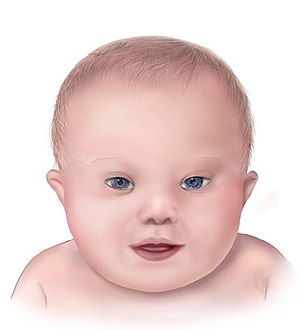Down syndrome or Down's syndrome, also known as trisomy 21, is a genetic disorder caused by the presence of all or part of a third copy of chromosome 21. It is usually associated with physical growth delays, mild to moderate intellectual disability, and characteristic facial features. The average IQ of a young adult with Down syndrome is 50, equivalent to the mental ability of an eight- or nine-year-old child, but this can vary widely. The parents of the affected individual are usually genetically normal. The probability increases from less than 0.1% in 20-year-old mothers to 3% in those of age 45. The extra chromosome is believed to occur by chance, with no known behavioral activity or environmental factor that changes the probability. Down syndrome can be identified during pregnancy by prenatal screening followed by diagnostic testing or after birth by direct observation and genetic testing. Since the introduction of screening, Down syndrome pregnancies are often aborted. There is no cure for Down syndrome. Education and proper care have been shown to improve quality of life. Some children with Down syndrome are educated in typical school classes, while others require more specialized education. Some individuals with Down syndrome graduate from high school, and a few attend post-secondary education. In adulthood, about 20% in the United States do paid work in some capacity, with many requiring a sheltered work environment. Support in financial and legal matters is often needed. Life expectancy is around 50 to 60 years in the developed world with proper health care. Regular screening for health problems common in Down syndrome is recommended throughout the person's life. Down syndrome is one of the most common chromosome abnormalities in humans. It occurs in about 1 in 1,000 babies born each year. In 2015, Down syndrome was present in 5.4 million individuals globally and resulted in 27,000 deaths, down from 43,000 deaths in 1990. It is named after British doctor John Langdon Down, who fully described the syndrome in 1866. Some aspects of the condition were described earlier by French psychiatrist Jean-Étienne Dominique Esquirol in 1838 and French physician Édouard Séguin in 1844. The genetic cause of Down syndrome was discovered in 1959.

Alias
Down's syndrome, Down's, trisomy 21
Icd10
Q90.
Icd9
758.0
Mesh id
D004314



Comment
0